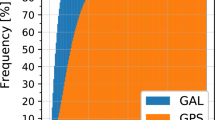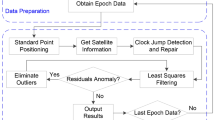Abstract
The accuracy of standalone GPS positioning improved significantly when Selective Availability was turned off in May 2000. With the availability of various public GPS related products including precise satellite orbits and clocks, and ionosphere maps, a single-frequency standalone user can experience even a further improvement of the position accuracy. Next, using carrier phase measurements becomes crucial to smoothen the pseudorange noise. In this contribution, the most critical sources of error in single-frequency standalone positioning will be reviewed and different approaches to mitigate the errors will be considered. An optimal filter (using also carrier phase measurements) will be deployed. The final approach will then be evaluated in a decently long static test with receivers located in different regions of the world. Kinematic experiments have also been performed in various scenarios including a highly dynamic flight trial. The accuracy, in general, can be confirmed at 0.5 m horizontal and 1 m vertical, with static tests. Ultimate results demonstrate an accuracy close to 2 dm (95%) for the horizontal position components and 5 dm (95%) for the vertical in the flight experiment.









Similar content being viewed by others
Notes
Strictly, smoothing implies the computation of estimates for unknown parameters (e.g. position coordinates) pertaining to epoch tk, using observations from the whole data collection period, i.e. [t1, tl] with 1 ≤ k ≤ l; the data period extends beyond epoch tk. Filtering refers to estimates for parameters at epoch tk, using solely data up to and including epoch tk, i.e. [t1, tk]. Filtering allows real-time operation and smoothing does not. In this paper, we continue to refer to ‘phase smoothing’, as commonly done, but strictly filtering is meant instead.
References
Baarda W (1968) A testing procedure for use in geodetic networks. NCG-publications on geodesy, Vol. 2, No. 5, Delft
Bisnath SB, Beran T, Langley RB (2002) Precise platform positioning with a single GPS receiver. GPS World, April 2002, pp 42–49
CODE (2005). Center for Orbit Determination in Europe. Astronomy Institute, University of Berne. http://www.aiub.unibe.ch/igs.html
DO-229A (1998) Minimum operational performance standards for global positioning system/wide area augmentation system airborne equipment. Document No. RTCA/DO-229A. Prepared by SC-159, 1998
Hatch R (1982) The synergism of GPS code and carrier measurements. In: Proceedings of the 3rd international geodetic symposium on satellite doppler positioning, Vol. 2. Las Cruces–New Mexico, 1982, pp 1213–1231
IGS (2005) International GPS Service. Website http://www.igscb.jpl.nasa.gov/
Kleijer F (2004) Troposphere delay modeling and filtering for precise GPS leveling. Ph.D thesis. Mathematical Geodesy and Positioning, Delft University of Technology
Kouba J, Héroux H (2001) Precise point positioning using IGS orbit and clock products. GPS Solut 5(2):12–28
Lachapelle G, Cannon ME, Qiu W, Varner C (1996) Precise aircraft single-point positioning using GPS post-mission orbits and satellite clock corrections. J Geodesy 70:562–571
Le AQ, Tiberius CCJM (2003).GPS Standard positioning service: how good is it?. Eur J Navig 1(2):21–27
Le AQ (2004) Achieving decimetre accuracy with single frequency standalone gps positioning. In: Proceedings of the ION GNSS 17th International Technical Meeting of the Satellite Division, 21–24 Sept. 2004, Long Beach, pp 1881–1892
Le AQ, Teunissen PJG (2006) Recursive least-squares filtering of pseudorange measurements. In: European navigation conference 2006, 7–10 May 2006, Manchester, (accepted for publication)
Marel van der H (1998) Monitoring of the Dutch active GPS reference system. In: Proceedings of IGS network systems workshop, Annapolis, 2–5 November, 1998, pp 171–172
Montenbruck O, Gill E, Kroes R (2005) Rapid orbit determination of LEO satellites using IGS clock and ephemeris products. GPS Solut 9(3):226–235
Muellerschoen RJ, Iijima B, Meyer R, Bar-Sever Y (2004) Real-time point-positioning performance evaluation of single-frequency receivers using NASA’s global differential GPS system. In: Proceedings of the ION GNSS 17th International Technical Meeting of the Satellite Division, 21–24 Sept. 2004, Long Beach, pp 1872–1880
Øvstedal O (2002) Absolute positioning with single frequency GPS receivers. GPS Solut 5(4):33–44
Parkinson BW, Spilker JJ (eds) (1996) Global positioning system: theory and applications vol. 1. Progress in astronautics and aerodynamics. Vol. 163. AIAA, Washington
Remondi BW (1993) NGS second generation ASCII and binary orbit formats and associated interpolation studies. In: IAG Symposia (Symp. 109, Vienna, Austria, August 11–14, 1989) by IUGG, and IAG
Satirapod C, Rizos C, Wang J (2001) GPS single point positioning with SA off: how accurate can we get? Surv Rev 36(282):255–262
Schaer S, Gurtner W, Feltens J (1998) IONEX: the ionosphere map exchange format version 1. Proceedings of the IGS AC Workshop, Darmstadt, February 9–11, 1998
Schaer S (1999) Mapping and predicting the earth’s ionosphere using the global positioning system. Ph.D thesis. AIUB, University of Berne
Schenewerk M (2003) A brief review of basic GPS orbit interpolation strategies. GPS Solut 6(4):265–267
Teunissen PJG (1990) Quality control in integrated navigation systems. IEEE Aerosp Electron Syst Mag 5(7):35–41
Teunissen PJG (1991) The GPS phase-adjusted pseudorange. In: Proceedings of the 2nd international workshop on high precision navigation Stuttgart/Freudenstadt, Germany, 1991, pp 115–125
Acknowledgments
The flight data (as well as the photograph of the aircraft) were kindly provided by José Lorga of the Control and Simulation division, Faculty of Aerospace Engineering, Delft University of Technology. Also the effort of the aircraft crew is appreciated in performing the special maneuvers.
Author information
Authors and Affiliations
Corresponding author
Rights and permissions
About this article
Cite this article
Le, A.Q., Tiberius, C. Single-frequency precise point positioning with optimal filtering. GPS Solut 11, 61–69 (2007). https://doi.org/10.1007/s10291-006-0033-9
Received:
Accepted:
Published:
Issue Date:
DOI: https://doi.org/10.1007/s10291-006-0033-9




